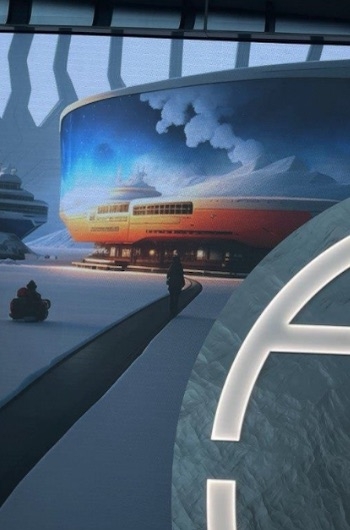Exhibition Stand Construction: What It Is and the Steps to Achieving Your Dream Stand
Describing the A to Z steps for ordering your exhibition stand.

What is an Exhibition Stand and Do You Need One?
The official definition of an exhibition stand is a designated area within an exhibition pavilion where product demonstrations take place. The earliest prototypes of exhibition stands can be considered mobile vans that could transform into stages or trade pavilions. However, today, exhibition stands have evolved far beyond their original purpose of direct service sales. In the modern world, an exhibition stand is the face of a company, its business card, a showcase of achievements, and a mobile office all in one. How you present yourself at an exhibition or forum directly affects your company's image, sales volume, and the number of signed partnership agreements.
Exhibition stands vary in complexity—from standard frame structures designed for simple banner displays to multi-story, intricate constructions made of composite materials equipped with computers and specialized equipment. The development of such unique, reputation-building compositions involves dozens of specialists—designers, engineers, production staff, decorators, and artists, not to mention construction workers. So, where should you start building?
Exhibition Stand Construction Guide: From A to Z
The first step is to define your goal. This is essential before starting the construction process. The key criteria are attainability, clarity, and tangibility. Participating in a forum is great, but it's even better to increase brand recognition, close several deals, and find a new business partner. Ask yourself: What do you consider a positive result? How will you measure success? What type of clients and partners are you looking for? Are they everyday consumers, corporate executives, or industrial directors? Will you be demonstrating product samples? Collecting contact information? How much time and budget do you have for the exhibition? No matter how you answer these questions, participation in an exhibition is highly recommended. Remember, where you fail to make your brand visible, your competitors will. Be creative! Creativity shapes your image, sells impressions, and gives you a competitive advantage.
Use the latest technology: AR and VR can provide immersive experiences, multi-sensory engagement with sounds, scents, and tactile sensations, activating all senses and making your presentation unforgettable. Also, leverage proven techniques such as selfie zones and photo booths, as well as video presentations of your products and services.
Stages of Exhibition Stand Development and Construction
- Choosing a Location is a critical step, as all subsequent decisions depend on it. Where is the pavilion located? Major forums and central exhibition centers provide placement maps where you can select your space. Keep in mind that visitor flow and available space directly impact both price and results. A location at the end of a row or in a corner is less favorable than a central, high-traffic spot, especially if it's an island or multi-level complex that serves as a focal point. Request all necessary data for planning. The absence of columns, hatches, permanent structures, overhead air conditioning units, and a suitable ceiling height are definite advantages. One often overlooked factor is neighboring exhibitors—consider their locations and strategize on how to attract visitors to your stand instead of losing them to competitors.
- Now that you have the foundation for your exhibition stand, the next step is creating a technical specification. The primary decision here is choosing who will develop the design project and build the pavilion. Opt for reputable companies with experience and portfolios, especially in Moscow and St. Petersburg. Your choice will depend on budget constraints and time limitations. Naturally, we recommend hiring professionals—such a company will have knowledgeable managers who understand the tasks, help define your goals, and offer a solution that fits your budget. For example, our Communication Agency 4D guarantees high-quality execution of all design and production processes. (Learn more about exhibition services.) If you work with professionals, congratulations—about 90% of the workload will be handled by them. The briefing stage (where your goals are discussed with the agency’s managers and designers) is crucial. Clearly define your objectives and budget early on. Save time by researching top global expos like Consumer Electronics Show (CES), CeBIT, as well as major Russian events like SPIEF in St. Petersburg, MosBuild, and the Russia Expo.
- A high-quality design project takes time. Creating a design and its visualization typically takes up to a month, considering revisions and approvals. This process factors in the pavilion’s location, layout, visitor traffic flow, zoning, building regulations, engineering capabilities, budget, and more. Be an innovator—use the latest developments in the expo industry, and don’t forget creativity. You will be presented with several project options; after choosing one and finalizing revisions, you will receive a project ready for implementation. We strongly discourage making changes after the project has been handed off for production—last-minute decisions can cause delays if the construction team lacks the technical capabilities or materials for modifications, leading to an incomplete stand and a poor impression.
- For large contractors, all processes follow a strict schedule. Your role is to oversee the process and sign documents upon the stand's completion. This may also include contracts for renting equipment instead of purchasing it. However, if you decide to outsource different aspects—automation to one company, lighting to another, and purchase equipment separately—you'll need significant time for coordination, full involvement in the manufacturing process, and additional logistics. Allocate extra time and budget for finding suppliers, manufacturing various components, and storing construction materials and equipment.
- Installation begins with organizational arrangements. If you’ve delegated the event setup to a contractor, your role will be to inspect and sign off on the completed exhibition stand. If you’re working with multiple firms, plan the delivery of materials in advance, coordinate the workflow, and ensure compliance with the exhibition venue’s technical regulations. The setup process starts with preparing the exhibition area—marking zones, laying electrical wiring, and bringing in construction materials, furniture, and decor. Next, technical installations are set up, followed by major stand components. The first step is assembling any overhead structures (if included), then laying flooring, followed by decorative wall construction. Electrical cables and other communications are hidden beneath the flooring. The final steps include installing decorative elements to ensure the stand perfectly matches the approved design. For large exhibitions, final approvals may be needed from the venue's technical department before the stand is operational. During installation, maintain close communication with both the construction team and exhibition venue managers to ensure smooth completion and handover.
- The exhibition has concluded, and you've achieved your goals—closed important deals, found new partners, and boosted brand recognition. However, an equally important step is dismantling the stand. To avoid issues, dismantling should be considered during the design phase—the structure should be lightweight, easy to disassemble, transport-friendly, and suitable for disposal or reuse. If you worked with a professional contractor, they can handle dismantling for you. Otherwise, you'll need to arrange for disassembly, transport, and disposal of the stand components.
Where to Order a Turnkey Exhibition Stand Project?
Exhibitions and forums are powerful marketing tools that shape a company’s image, facilitate networking, and promote business growth. The easiest way to manage exhibition stand construction is to work with a trusted company. The EXPO division of Communication Agency 4D specializes in end-to-end exhibition support, ensuring seamless project execution in real time.
Our technical support includes:
- 3D modeling and design project development (visualizations, sketches);
- Stand construction, space zoning, furniture, decorative elements, multimedia integration, and bar area setup;
- Conceptual solutions for interactive engagement, including touch tables, video content, and live broadcasting;
- Technical documentation, communication with organizers, and venue coordination;
- Technical support for multimedia equipment—lighting, sound, and video.
We also offer organizational support, including logistics, promo staff recruitment, and event management. Our PR team provides comprehensive promotional assistance, invitation campaigns, photography and videography services, and branded merchandise production.
Maximize your investment and stand out from the competition! Contact us via Telegram, WhatsApp, or call +7 (812) 292 68 09 to schedule a meeting and discuss your project in detail.



